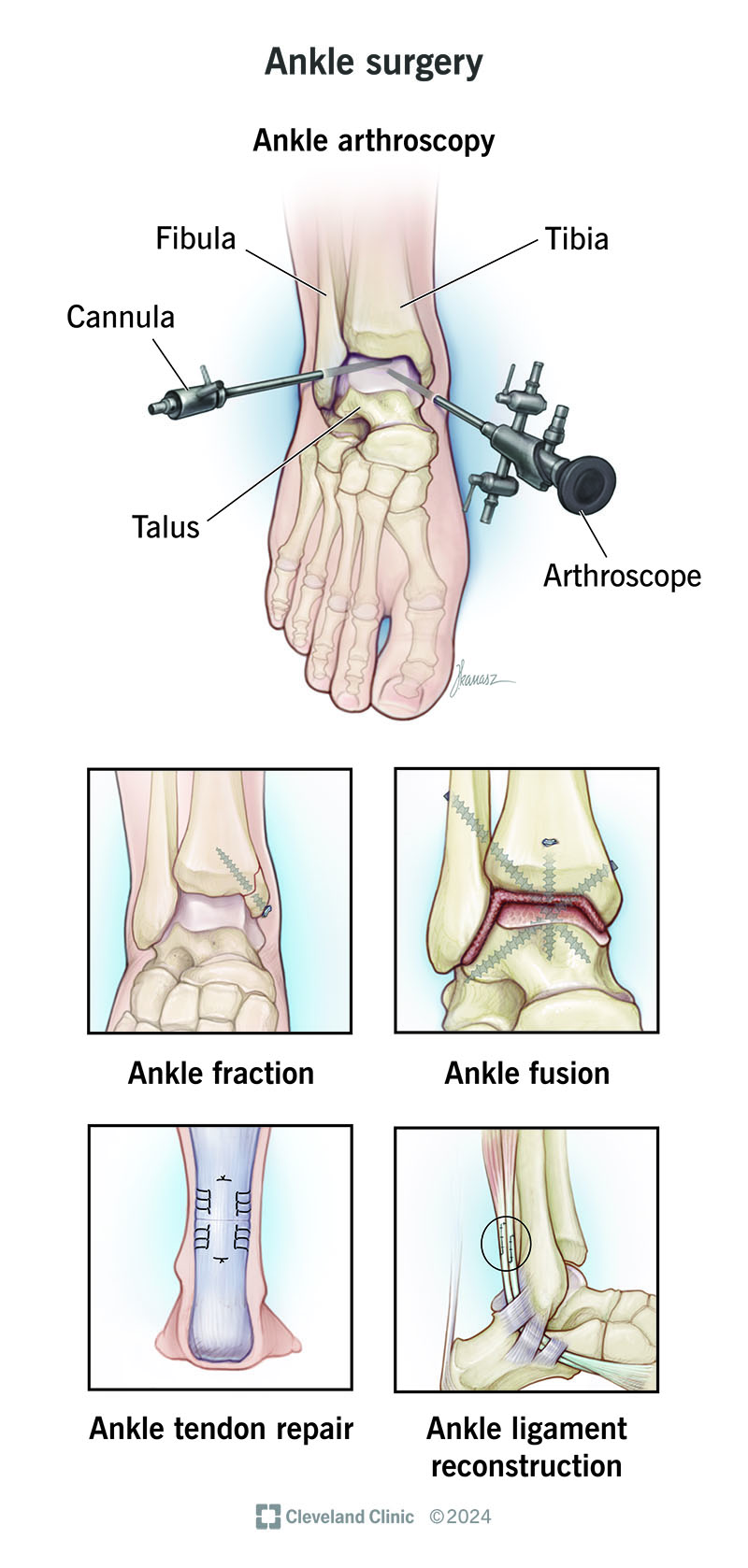Ankle replacement surgery (ankle arthroplasty) treats ankle arthritis by replacing damaged parts of your ankle joint with an artificial implant. Your healthcare provider may recommend this procedure if you’ve tried nonsurgical methods and they haven’t relieved your pain and other symptoms. Ankle replacement recovery may take up to a year.
Advertisement
Cleveland Clinic is a non-profit academic medical center. Advertising on our site helps support our mission. We do not endorse non-Cleveland Clinic products or services. Policy

Ankle replacement surgery (ankle arthroplasty) is a procedure that replaces damaged bones and cartilage in your ankle joint with a prosthetic implant. The plastic or metal parts of the artificial implant work together and move like your natural joint. The goal of total ankle replacement is to relieve pain and restore function in people with ankle arthritis.
Advertisement
Cleveland Clinic is a non-profit academic medical center. Advertising on our site helps support our mission. We do not endorse non-Cleveland Clinic products or services. Policy
Most people find relief from ankle pain and other symptoms of ankle arthritis with nonsurgical treatments, like medication, physical therapy, corticosteroid injections, and braces or orthotics. But when the pain doesn’t go away and you aren’t able to use your ankle despite these treatments, your healthcare provider may recommend ankle replacement surgery.
It’s important to go into surgery and rehabilitation (recovery) with realistic expectations. Talk to members of your care team about how to get ready for the procedure. Knowing what to expect can help you prepare for challenges and plan for recovery. Before surgery, your team may recommend that you:
Discuss what recovery might look like with your family and friends. Following surgery, you won’t be able to put any weight on your ankle — typically for four to six weeks. During that time, you may have to use a walker, crutches or a knee scooter. Make a plan for accomplishing daily tasks before your surgery. You may need help grocery shopping, getting up and down stairs, or caring for a pet.
On the day of your surgery, an anesthesiologist will give you general anesthesia and a nerve block so you don’t feel pain. Another healthcare provider will wrap a tourniquet around your leg to stop the blood flow to your ankle. This helps your orthopaedic surgeon see the surgical area clearly. Then, your surgeon will:
Advertisement
The procedure takes about two to three hours to complete.
An ankle replacement surgery helps you regain strength and stability in your ankle. The treatment also preserves your range of motion. The replacement parts articulate, or move together, like your natural joint. This flexibility can allow you to walk normally, with less pain, and return to a more active lifestyle.
Often, providers prefer ankle replacement over another type of ankle surgery — an ankle fusion (arthrodesis). Fusion surgery permanently joins your ankle bones together, limiting your range of motion. This loss of flexibility can affect the way you walk or cause arthritis to develop in other joints. Talk to your provider about which procedure — ankle replacement surgery or ankle fusion — best fits your unique needs.
Although rare, ankle arthroplasty can lead to complications. Possible risks of total ankle replacement include:
Ankle replacement is typically an inpatient procedure. That means you’ll stay in the hospital overnight for observation. But for ankle replacement surgery, you’ll usually only spend one night there. Some people may have outpatient surgery, meaning you can go home the same day.
For the first two weeks, you’ll wear a cast or splint to keep your ankle immobilized (unmoving) to help with healing. You’ll need to keep your leg elevated most of the time. You can use crutches or a walker to go short distances. You can also use a knee scooter.
Typically, a healthcare provider will remove your stitches two weeks after surgery. Then, you’ll start to wear a removable boot. At four to six weeks after surgery, you’ll be able to start putting a little weight on your foot. You’ll start physical therapy at this time to help guide your rehabilitation.
At three months, you can start wearing normal shoes and start light activity. You’ll continue physical therapy. Complete ankle replacement recovery can take anywhere from six to 12 months.
Advertisement
Physical therapy after surgery can help you regain mobility in your ankle. Rehabilitation may include:
Your healthcare provider will have you come in for scans and follow-up visits during your recovery. This extra care can ensure your ankle heals properly.
Contact your provider if you experience any of the following complications after surgery:
You can reduce your risk of complications after surgery by eating nutritiously and not smoking. Also, make sure to follow all medical instructions. Some people face an increased risk of developing problems after ankle replacement surgery. This group includes people who smoke or have a health condition like diabetes or an autoimmune disorder.
If you’ve been dealing with ankle pain due to arthritis for a while, you’re likely getting frustrated. You’ve iced it, taken medication and even tried physical therapy, but nothing seems to work. This is when ankle replacement surgery may come into play. Only your healthcare provider can decide if ankle replacement or another surgery is right for you. Make an appointment to talk to them about your options for finding relief.
Advertisement
When you need ankle surgery, you want experts by your side to help you through it. At Cleveland Clinic, we’ll be with you from start to finish.

Last reviewed on 09/22/2025.
Learn more about the Health Library and our editorial process.